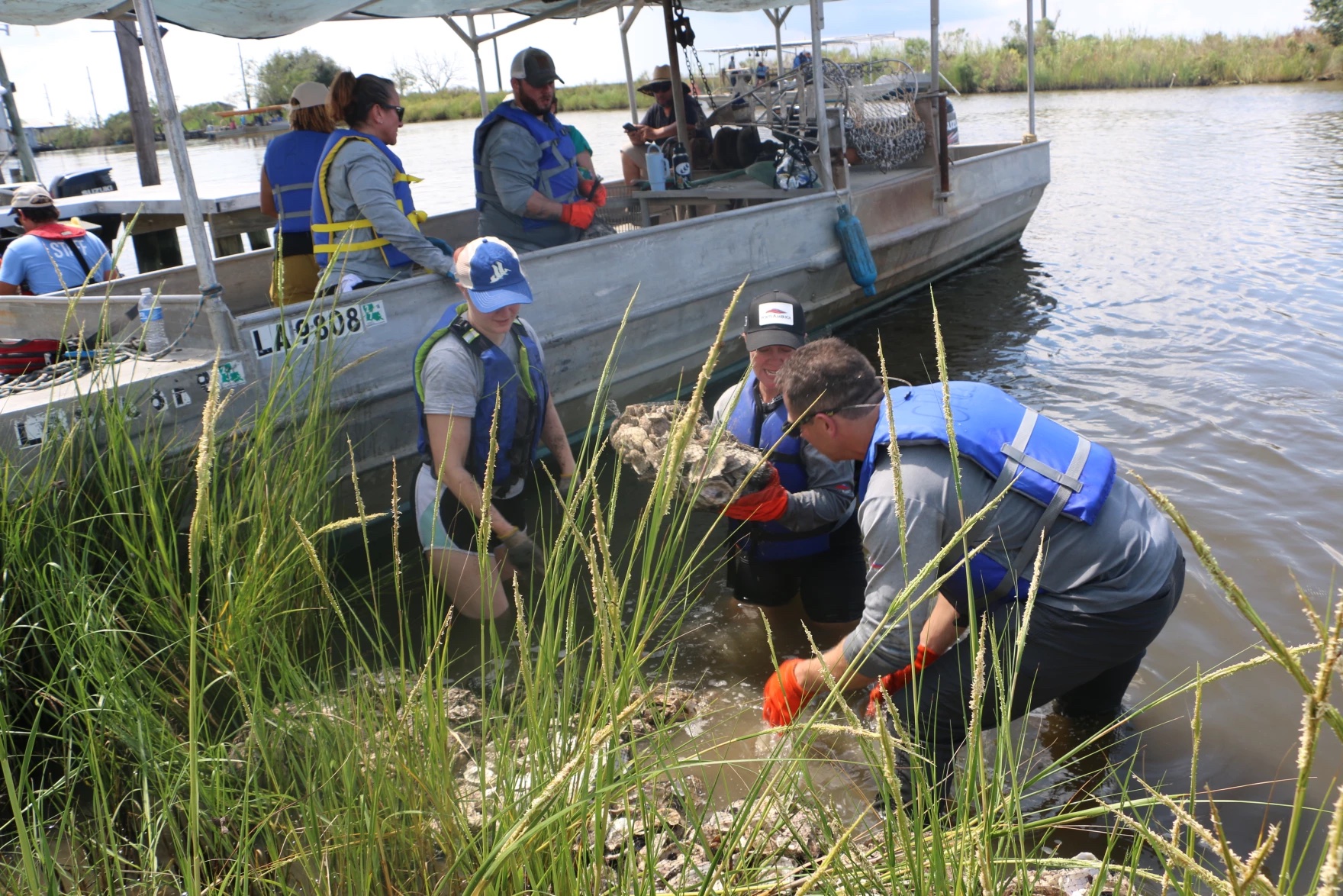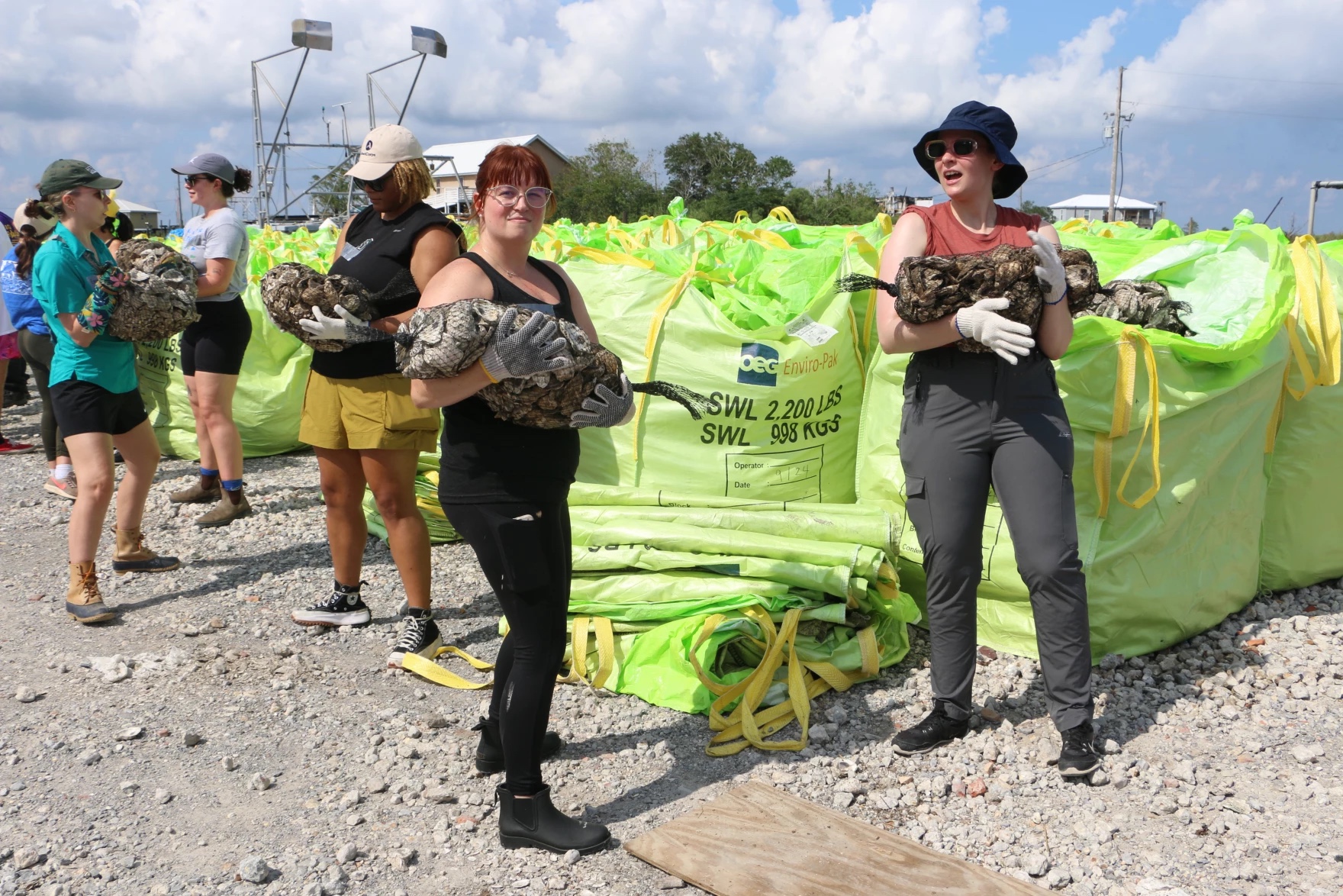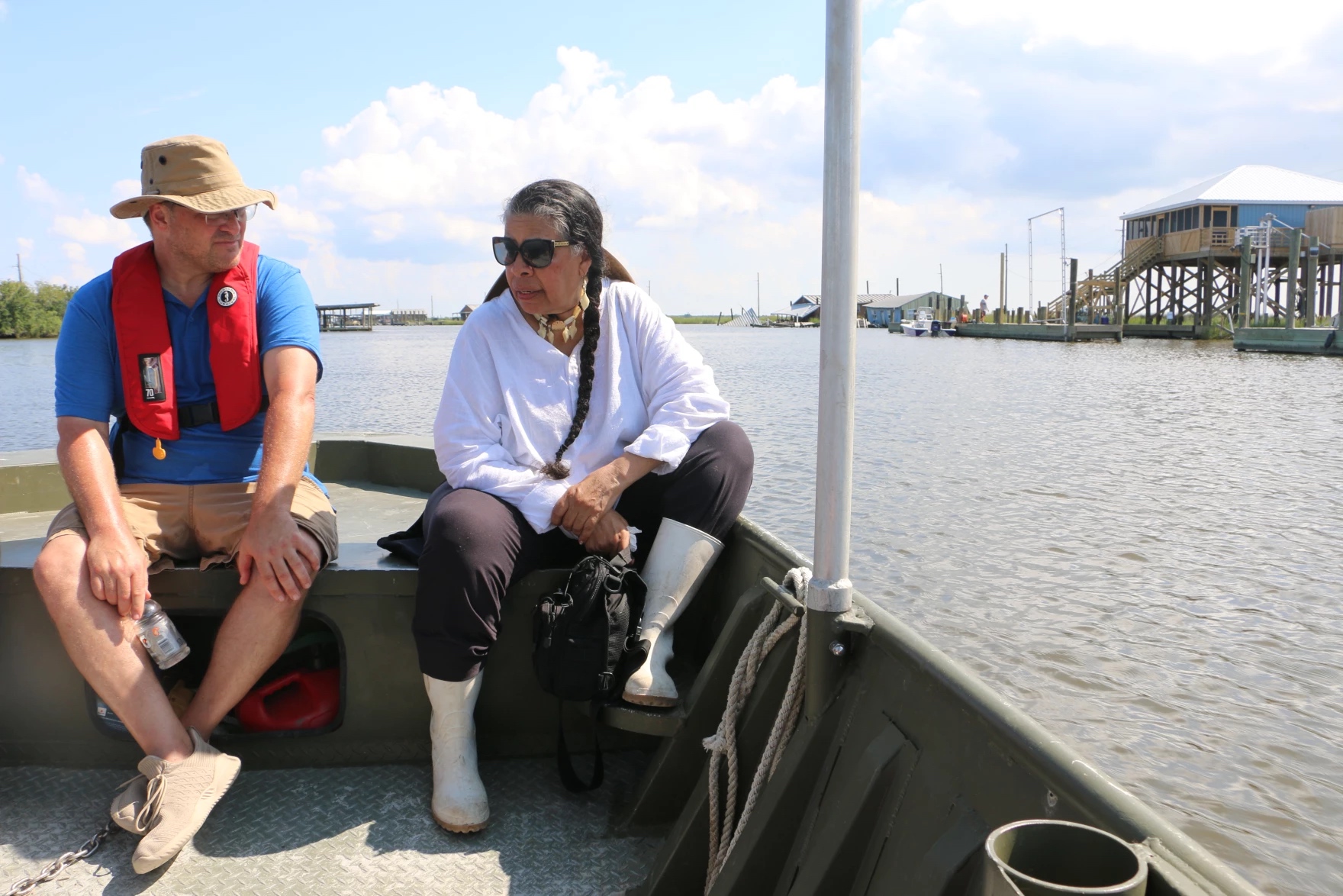Using Oyster Shell Reefs To Counter Sea Level Rise In Louisiana
5:39 minutes


This article is part of The State of Science, a series featuring science stories from public radio stations across the United States. This story, by Eva Tesfaye, was originally published by WWNO.
On a hot Friday morning, the sun beat down on volunteers gathered at the edge of the water in southern Plaquemines Parish. They passed heavy sacks of oyster shells to each other down a line.
“I feel like I’m gonna have massive biceps after this. It’s definitely an amazing workout,” said Hilary Nguyen, one of the volunteers for the Coalition for Coastal Louisiana, the organization that built the reef.

The volunteers loaded the shells onto boats to use them for building an oyster reef to help slow land loss in Grand Bayou Indian Village.
“The oyster reef is a living thing. Baby oysters are going to attach to it. It’s going to grow. It’s going to become bigger,” said James Karst with the coalition. “But when the sea level rises, because oysters are growing on it, it will grow vertically as well, so it will continue to add protection.”
Louisiana’s land loss is an existential crisis for many of the state’s tribes who live along the coast. Grand Bayou Indian Village, a small community, home to the Atakapa-Ishak/Chawasha tribe, is watching its lands wash away. Nearly 1,000 people lived in the village in the 1940s, but now there are only about a dozen homes raised on stilts right along the edge of the bayou. Boats are the only way to get around.
“You can look at the GPS and it will indicate a different color for where land is,” said Karst. “You’ll be looking at this on the screen, then you’ll look up and there is no land there. It’s just open water.”
Volunteers built the reef by stacking bags of recycled oyster shells in the water, up and down the shoreline. The shells came from restaurants in New Orleans. The coalition recently expanded its oyster recycling services to Baton Rouge.
Keep up with the week’s essential science news headlines, plus stories that offer extra joy and awe.
It’s the second reef the Coalition for Coastal Louisiana has built in partnership with the Atakapa-Ishak/Chawasha. The first protects the tribe’s Lemon Tree Mound, a piece of sacred land that was once elevated.
“That’s a remnant mound. It’s out in Bay Adams,” said Rosina Philipe, a tribal council member and the tribe’s knowledge holder. “It’s surrounded by water because the land has changed so dramatically over a period of time.”

The reef protecting Lemon Tree Mound was built two years ago. It’s covered with shells, baby oysters, mussels, snails and crabs.
“This is an oyster drill conch. This is a predatory snail that actually eats oysters,” said Richie Blink, who runs Delta Discovery Tours and drove the boat, “So that’s just telling us that there’s oysters that are actually here. Fishermen don’t like these very much.”
Small waves rippled in front of the reef, but behind it, closer to the land, the water was almost completely still, meaning there’s less erosion. At the same time, the tribe knows these reefs won’t be enough to completely stop the land from disappearing, but Phillippe said they’re worth it anyway to buy time.

“It will eventually succumb to the waters in the waves, which is okay,” she said. “But the reef that was created there will serve as not only a marker of where that site was, but it actually encourages marine life to congregate there and to repopulate the area.”
The land where their houses are built could face a similar fate, so the tribe is looking into more solutions such as floating houses and gardens.
“We’re water people, so we’re learning to live with more water now,” she said. “Less land, more water, but we’re still going to be here.”
Invest in quality science journalism by making a donation to Science Friday.
Eva Tesfaye is a reporter with KCUR, Harvest Public Media, Mississippi River Basin Ag & Water Desk in Kansas City, Missouri.
KATHLEEN DAVIS: And to close out the hour, it’s time to check in on the state of science.
SPEAKER 1: This is KERN.
SPEAKER 2: For WWNO–
SPEAKER 3: St. Louis Public Radio.
SPEAKER 4: Iowa Public Radio news.
KATHLEEN DAVIS: Local science stories of national significance. As we’re seeing sea levels rise across the world, we’re also seeing how communities close to the water are responding differently to it. In Louisiana’s Grand Bayou Indian Village near New Orleans, tribes are witnessing their historic lands disappear underwater, and their solution for now is oysters. Here to tell us more is my guest, Eva Tesfaye, Coastal Reporter at WWNO in New Orleans. Eva, welcome back to Science Friday.
EVA TESFAYE: Thanks for having me.
KATHLEEN DAVIS: So can you tell us about what this tribe has been going through?
EVA TESFAYE: Yeah. So like you said, Grand Bayou Indian Village– it’s about an hour south of New Orleans. It’s in Plaquemines Parish along the Mississippi River. It’s home to the Atakapa-Ishak/Chawasha tribe. It’s a very small village. In the ’40s, there was about a thousand people living there. And now there’s only about a dozen. They live in the marsh, and you can only get around by boat. So that means all the homes have been raised on stilts to help deal with hurricanes. And they’ve lost a lot of people. A lot of people have moved out. But they’re also losing land. And that’s obviously due to sea level rise that’s driven by climate change, and it’s causing their land to disappear.
KATHLEEN DAVIS: And I’ve heard that this is getting so bad that GPS maps aren’t even accurate anymore. Is that right?
EVA TESFAYE: Yeah. One person I was talking to while I was down there says, sometimes you’ll be looking at the GPS and you’ll see land on the map, and then you just look up and it’s all water.
KATHLEEN DAVIS: Oh, my gosh. So tell me how oysters play into all of this.
EVA TESFAYE: So this was a project between Grand Bayou and the Coalition to Protect Coastal Louisiana. Basically, the coalition brought a bunch of volunteers and a bunch of bags of recycled oyster shells, and they had the volunteers stack the shells all along the shoreline in front of people’s houses. So these shells will help slow the water and help protect that land from erosion, but it’s also a living reef. So oysters will attach. It’ll create this beautiful little ecosystem. And that means the reef will also grow as the sea level rises and continue providing that protection.
KATHLEEN DAVIS: And you were there. Was it easy to see the effect that these oysters were having?
EVA TESFAYE: Yeah. So this was the second time the coalition has done this kind of project with Grand Bayou. They actually chose to do this to protect one of their sacred mounds first. That’s called the Lemon Tree Mound. So we went to go see how that reef was doing. It was installed about two years ago, and Richie Blink was the boat captain. He took us out there. He runs Delta Discovery Tours. He pointed out how the oysters and other critters are already attaching to the reef.
RICHIE BLINK: So this is an oyster drill conch. So this is a predatory snail that actually eats oysters. So this is telling us that there’s oysters that are actually here. Fishermen don’t like these very much.
EVA TESFAYE: So there are all these snails and crabs and things attached to the reef. And what I also noticed is you can really see how the reef is slowing down the water. There’s waves on one side, but the water between the oyster reef and the mound was almost completely still.
KATHLEEN DAVIS: Wow. So I can imagine we’re talking about a lot of oysters here, right? Where is the tribe getting them?
EVA TESFAYE: The reef they built to protect their homes was 900 feet long. So yeah, that’s thousands of oyster shells. And yeah, they get them from restaurants in New Orleans. The coalition also just expanded to collecting from restaurants in Baton Rouge. So it’s a nice way to recycle these oyster shells and bring them back into the environment.
KATHLEEN DAVIS: So this starts with recycled oyster shells, but then it becomes a place for living oysters and other kinds of marine animals. At the same time, it makes flooding from storms less of an issue. But they can only help so much, I’m guessing. Is that a correct read on that?
EVA TESFAYE: Yeah. I talked to Rosina Philippe. She’s a tribal council member and the tribe’s knowledge holder, and she talked about that. She basically said, they know it won’t be enough to stop the land from disappearing completely, especially for Lemon Tree Mound.
ROSINA PHILIPPE: It will eventually succumb to the waters and the waves, which is OK. But the reef that was created there will serve as not only a marker of where that site was, but it actually encourages marine life to congregate there and to repopulate the area.
EVA TESFAYE: So basically, it’s worth it anyway because they’re taking care of not only their land, but they’re also taking care of the marine environment.
KATHLEEN DAVIS: So what would this tribe do if their land disappears?
EVA TESFAYE: Well, they’re not going to leave. Philippe made that very clear to me– that this is their home, and they’re going to stay no matter what. And, like I said, they already raised their homes on stilts. They’re also looking into floating houses and gardens and other adaptation methods. Philippe says they are historically a water people. They would move to adapt to the water as it changed historically. So now they’re just returning to that way of life and relearning how to live with water.
KATHLEEN DAVIS: Well, that’s all the time that we have for now. I’d like to thank my guest, Eva Tesfaye, Coastal Desk Reporter for WWNO in New Orleans. Thanks so much for joining us.
EVA TESFAYE: Thank you.
Copyright © 2024 Science Friday Initiative. All rights reserved. Science Friday transcripts are produced on a tight deadline by 3Play Media. Fidelity to the original aired/published audio or video file might vary, and text might be updated or amended in the future. For the authoritative record of Science Friday’s programming, please visit the original aired/published recording. For terms of use and more information, visit our policies pages at http://www.sciencefriday.com/about/policies/
Dee Peterschmidt is a producer, host of the podcast Universe of Art, and composes music for Science Friday’s podcasts. Their D&D character is a clumsy bard named Chip Chap Chopman.
Kathleen Davis is a producer and fill-in host at Science Friday, which means she spends her weeks researching, writing, editing, and sometimes talking into a microphone. She’s always eager to talk about freshwater lakes and Coney Island diners.